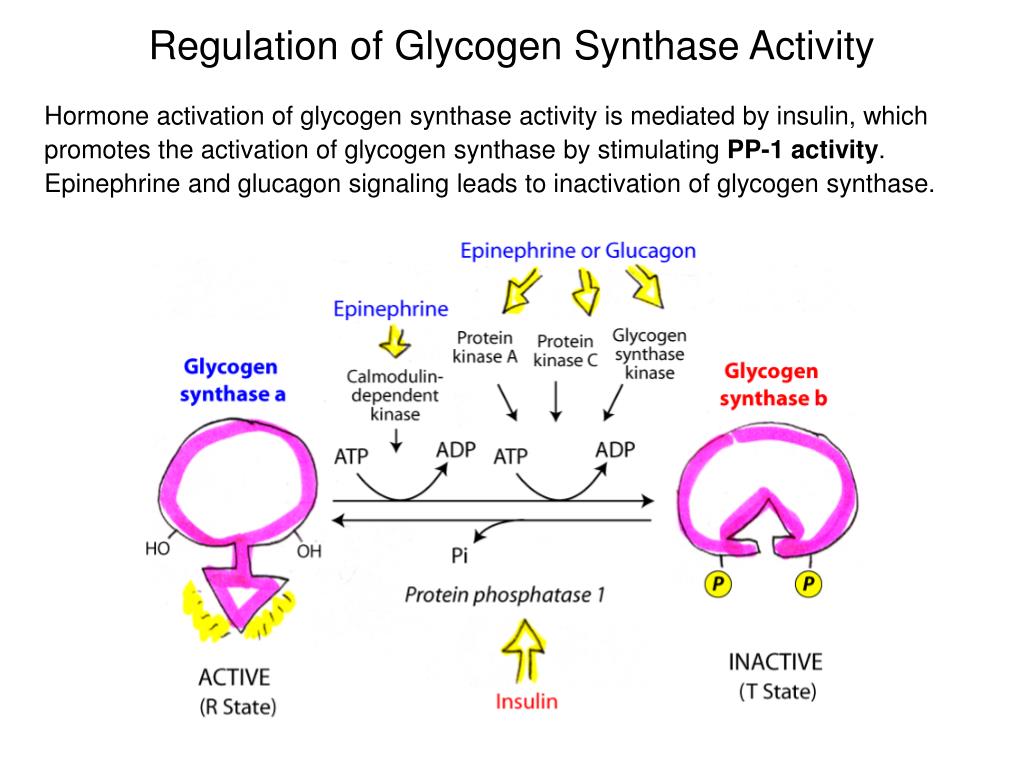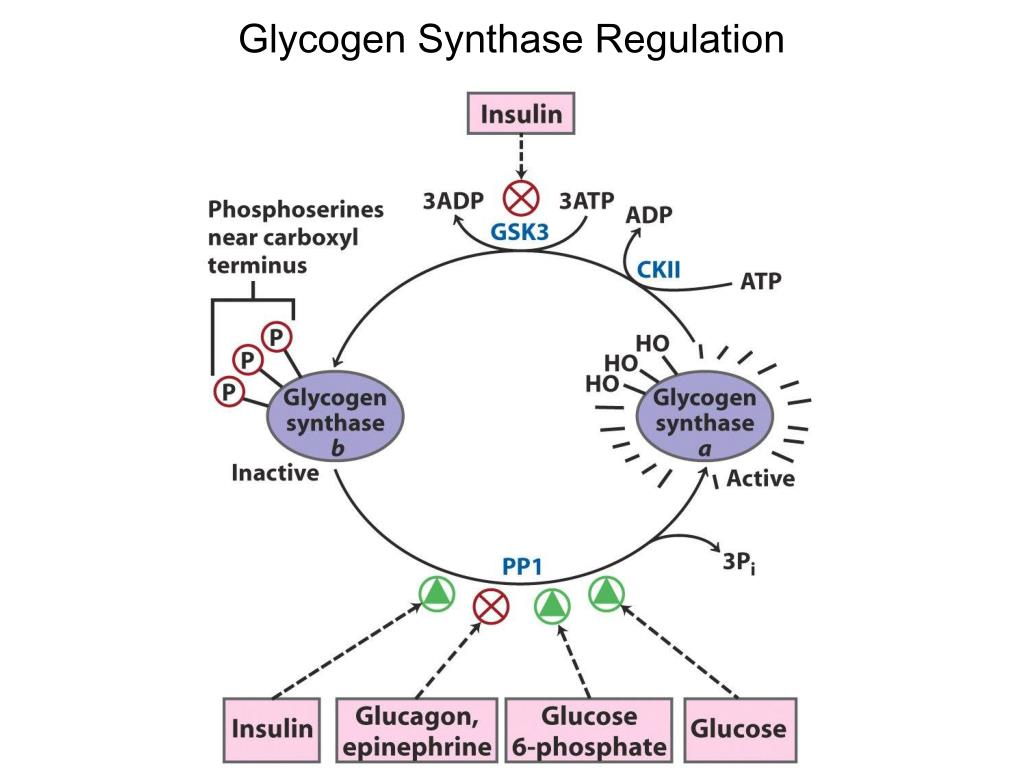Regulation of Glycogen Synthase in Liver – Maintaining Energy Balance Glycogen synthase regulation plays a crucial role in liver metabolism, ensuring the efficient storage and release of glucose when needed. This process is vital for maintaining energy balance within the body. In this article, we will explore the intricate mechanisms that control the activity of glycogen synthase in the liver and shed light on its importance in metabolic homeostasis. Subheading 1: Understanding Glycogen Synthase Regulation Glycogen synthase, an enzyme responsible for glycogen synthesis, is under tight regulation in the liver. This ensures the timely storage of excess glucose and its subsequent release as needed. Let's delve into the various factors that influence glycogen synthase activity. 1.1 Hormonal Regulation: - Insulin: Insulin, an anabolic hormone secreted by the pancreas, plays a pivotal role in glycogen synthase regulation. It stimulates glycogen synthesis by activating protein phosphatase 1 (PP1), a key regulator of glycogen synthase activity. - Glucagon: In contrast to insulin, glucagon, a hormone secreted by the pancreas, elevates blood glucose levels during periods of low glucose availability. Glucagon inhibits glycogen synthase through the activation of protein kinase A (PKA). 1.2 Substrate Availability: - Glucose Levels: A high concentration of glucose in the liver promotes glycogen synthesis. Glycogen synthase is activated when intracellular glucose levels are elevated, allowing for the efficient conversion of glucose into glycogen. - Glycogen Levels: When glycogen storage within the liver is full, glycogen synthase activity is suppressed. This prevents excessive glycogen accumulation and ensures the availability of glucose in the bloodstream. 1.3 Enzymatic Modulation: - Phosphorylation: Glycogen synthase is regulated through phosphorylation by various kinases. Phosphorylated glycogen synthase is inactivated, whereas dephosphorylation restores its activity. - Glycogen Synthase Kinase 3 (GSK3): GSK3 is a critical kinase that phosphorylates and inhibits glycogen synthase. Its activity is regulated by insulin and a variety of other signaling molecules. Subheading 2: Insight into Glycogen Synthase Regulation Mechanisms In this section, we will dive deeper into the molecular pathways involved in the regulation of glycogen synthase activity. 2.1 Insulin Signaling Pathway: Insulin binds to its receptors on liver cells, initiating a cascade of intracellular events that ultimately influence glycogen synthase activity. This signaling pathway involves the activation of protein phosphatase 1 and the subsequent dephosphorylation of glycogen synthase, leading to its activation. 2.2 Glucagon Signaling Pathway: Glucagon acts through G protein-coupled receptors, triggering the activation of adenylate cyclase. This enzyme, in turn, generates cyclic adenosine monophosphate (cAMP), activating PKA. PKA phosphorylates glycogen synthase, suppressing its activity and inhibiting glycogen synthesis. 2.3 Glycogen Synthase Control Points: Glycogen synthase is subjected to multiple levels of regulation, allowing for fine-tuning of glycogen synthesis. Several proteins, including glycogen-targeting subunits, anchoring proteins, and phosphorylase kinase, control the accessibility of glycogen synthase to its regulators, such as protein phosphatase 1 and PKA. Subheading 3: FAQs about Glycogen Synthase Regulation Q1: How does glycogen synthase regulation affect glucose homeostasis? A1: Glycogen synthase regulation ensures the efficient storage and release of glucose, enabling glucose homeostasis. During periods of high blood glucose, glycogen synthase is activated, allowing for glycogen synthesis. When blood glucose levels drop, glycogen stored in the liver is broken down via the activation of glycogen phosphorylase. Q2: What happens when glycogen synthase is constantly activated? A2: Constant activation of glycogen synthase can lead to excessive glycogen storage and may result in metabolic disorders such as glycogen storage diseases or insulin resistance. Q3: Are there any therapeutic implications of glycogen synthase regulation? A3: Understanding the intricacies of glycogen synthase regulation opens up possibilities for therapeutic interventions targeting various metabolic disorders. For instance, drugs aimed at modulating glycogen synthase activity could help manage conditions such as diabetes and liver diseases. In conclusion, glycogen synthase regulation in the liver is a tightly controlled process that ensures optimal energy balance and glucose homeostasis. Through hormonal signaling, substrate availability, and enzymatic modulation, glycogen synthase activity is precisely regulated to meet the energy demands of the body. By unraveling the complexities of glycogen synthase regulation, researchers aim to develop novel therapeutic strategies for metabolic disorders in the future. Please note: The content provided in this article is based on scientific research and is intended for informative purposes only. For personalized medical advice, please consult a healthcare professional.
Regulation Glycogen Synthase
 Image Source : regulationlatest.blogspot.com
Image Source : regulationlatest.blogspot.com glycogen synthase metabolism control biochemistry glossary
Regulation Of Glycogen Synthase In Liver. Glycogen Synthase Is
 Image Source : www.researchgate.net
Image Source : www.researchgate.net glycogen synthase liver vasopressin glucose
Glycogen Synthase Regulation - YouTube
 Image Source : www.youtube.com
Image Source : www.youtube.com glycogen synthase regulation
4. Regulation Of Glycogen Synthesis And Degradation – Greek.doctor
 Image Source : greek.doctor
Image Source : greek.doctor glycogen synthesis degradation synthase phosphorylase kinase form casein phosphatase ckii breanna
PPT - Carbohydrate Metabolism 2: Glycogen Degradation, Glycogen
 Image Source : www.slideserve.com
Image Source : www.slideserve.com glycogen regulation synthase metabolism synthesis degradation activity ppt activation carbohydrate reciprocal phosphorylase insulin powerpoint presentation slideserve
Regulation Of Glycogen Metabolism By Glycogen Synthase And Glycogen
 Image Source : www.researchgate.net
Image Source : www.researchgate.net glycogen synthase regulation metabolism phosphorylase glucagon kinase degradation phosphatase epinephrine receptors pka pp1 activates phk inactive g1p phosphoprotein
PPT - Chapter 15 PowerPoint Presentation, Free Download - ID:4069798
 Image Source : www.slideserve.com
Image Source : www.slideserve.com glycogen synthase regulation ppt chapter powerpoint presentation insulin breakdown
Regulation Of Glycogen Synthesis And Breakdown - Principles Of
 Image Source : jackwestin.com
Image Source : jackwestin.com Glycogen synthesis degradation synthase phosphorylase kinase form casein phosphatase ckii breanna. Regulation of glycogen synthase in liver. glycogen synthase is. Glycogen regulation synthase metabolism synthesis degradation activity ppt activation carbohydrate reciprocal phosphorylase insulin powerpoint presentation slideserve. Glycogen synthase regulation. Glycogen synthase metabolism control biochemistry glossary
 Image Source : www.researchgate.net
Image Source : www.researchgate.net  Image Source : www.youtube.com
Image Source : www.youtube.com  Image Source : greek.doctor
Image Source : greek.doctor  Image Source : www.slideserve.com
Image Source : www.slideserve.com  Image Source : www.researchgate.net
Image Source : www.researchgate.net  Image Source : www.slideserve.com
Image Source : www.slideserve.com  Image Source : jackwestin.com
Image Source : jackwestin.com